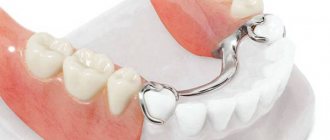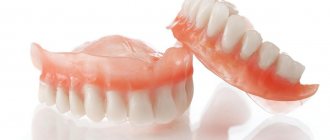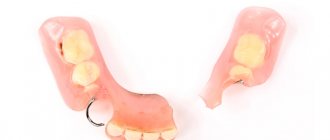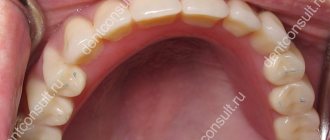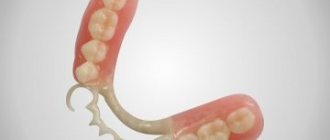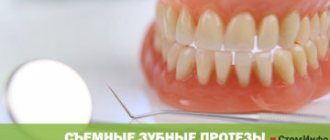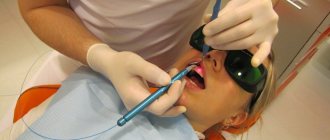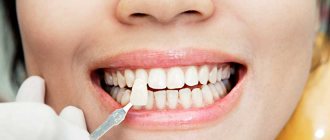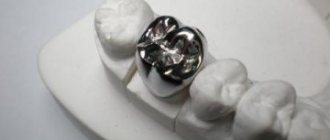517
Artificial dental prosthetics often becomes an inaccessible procedure for a number of patients.
The reason for this is a number of contraindications, the main of which are dental diagnoses and individual intolerance to the components of the prosthesis, which can provoke an acute allergic reaction.
The designs discussed in this article solve this problem by 95%.
General overview
Polyurethane dentures are a removable type of device , which is an analogue of models made of nylon.
They are attached to the supporting organs using standard methods. Moreover, in a number of technical characteristics this material is several times superior to nylon.
Polyurethane is a very plastic and soft component, at the same time it is quite durable and copes well with pressure loads, and is resistant to temperature changes, which has a positive effect on the service life of the structure.
In addition, the material is able to repel moisture, which is very important for oral hygiene - this property prevents the formation of plaque and eliminates the appearance of unpleasant odors caused by the accumulation of microbes.
Installation and care of soft dentures
The soft structures are very easy to use. To do this, the oral cavity is cleaned with a special solution. The removable structure is then put on to connect to the existing mount. For better adhesion to the gums, many patients use special glue when putting them on.
Caring for such soft removable devices is not at all labor-intensive.
They put on and take off easily and simply. Here are the basic rules for caring for soft dentures. For long-term service of such devices it is necessary:
- Daily cleansing with a brush (preferably 2-3 times a day, after meals).
- The use of abrasive pastes is prohibited, as it can damage the surface and lead to rapid failure of the prosthesis.
- Rinsing with water after eating is mandatory.
- Daily treatment with special disinfectant solutions and pastes (such as Protefix) to disinfect and combat unpleasant odors. Removing the structures at night is not necessary.
- After installing the structures, the food load should be increased gradually, starting with liquid food and then moving on to more solid types of food.
- It is prohibited to eat hard foods (crackers, nuts, large pieces of vegetables), as well as viscous foods (toffee, chewing gum).
- There may be a temporary deterioration in diction after installation.
- It is important to have your dentures professionally cleaned in a technical laboratory at least once a month.
If a breakdown occurs
Occasionally, flexible devices may also break. This can happen when:
- violation of the rules of use;
- excessively heavy loads;
- defects during the manufacturing process.
However, most often such a problem can be corrected and the plate can be repaired. And any repair is still cheaper than manufacturing new structures.
Price
Prices for soft dental appliances in various clinics and cities in Russia vary from 25,000 rubles (full denture) to 15,000 rubles (micro denture). For a partial structure to replace 10 teeth, you will have to pay about 20,000 rubles.
Indications and contraindications
This method of artificial dental restoration is indicated in the following cases:
- fragmentary absence of several adjacent units of the jaw row, resulting from mechanical trauma or dental amputation;
- diseases , the course of which is a contraindication to the installation of other options for prosthetic devices, in particular, diabetes mellitus, damage to periodontal tissues;
- pediatric dentistry , when there is a need for the formation of a temporary product. By replacing empty space, the prosthesis will not allow neighboring organs, which are very mobile in childhood, to move. This way you can prevent the development of malocclusions;
- weak gums;
- tendency to allergic manifestations.
Installation of polyurethane models is impossible for the only reason - the absence of too many teeth or their complete loss.
Advantages and disadvantages
Products made from polyurethane have received well-deserved recognition in the Russian consumer market for dental services, and such popularity is not accidental.
This type of design has a lot of important advantageous aspects in comparison with analog devices made from other materials:
- excellent biocompatibility - its indicator is several times higher than, for example, acrylic or metal. Moreover, the component is absolutely hypoallergenic;
- low cost - the price of such models is much more attractive than nylon or, say, ceramic systems;
- long service life - with proper care and careful treatment, the prosthesis will last no less than its analogues;
- color fastness – polyurethane is resistant to coloring pigments contained in many foods and drinks, which almost completely removes dietary restrictions. In addition, over time, it completely retains its original appearance and shade;
- high aesthetic value - this is the uniqueness of the material. As a rule, external quality is often achieved by using structures that are more complex in composition, which significantly increases the total cost of prosthetics services;
- resistance to physical stress - despite its apparent fragility and lightness, the material is able to withstand a fairly high pressing force that occurs during the process of chewing food fragments;
- ease of use - this is achieved by the light weight of the structure and gentle methods of fixing it;
- absence of metal elements - this minimizes the risk of injury;
- flexibility - this quality of the material allows the structure to instantly adapt to mechanical loads, while avoiding deformation of the product frame;
- resistance to a humid environment - the ability of polyurethane not to absorb moisture is protection against infectious lesions of the oral cavity.
The disadvantages include the impossibility of this method of prosthetics in clinical situations involving the absence of a large number of teeth, as well as a longer period of adaptation to the products.
In addition, the product is characterized by increased rigidity compared, for example, with acrylic components.
What are Butterfly microprostheses and what problems can be solved with their help.
Find out here about the purpose of a splinting clasp prosthesis.
At this address https://www.vash-dentist.ru/protezirovanie/semnyie-p/primenenie-uslovno.html we will find out what a conditionally removable denture means.
Disadvantages of polyurethane prostheses
Unlike fixed dentures, which cease to be felt in the mouth almost immediately after installation, removable dentures require getting used to. The exception is soft dentures, which appeared in dental practice relatively recently, but despite this, they have already survived periods of both enthusiastic reviews and very harsh criticism. Polyurethane prostheses went through the same thing.
Dentists believe that removable dentures are worse than fixed dentures. Fixed ones are better at replacing real teeth. But, unfortunately, due to various reasons, patients cannot always use fixed dentures.
Polyurethane dentures are soft and elastic, and this is not always an indisputable advantage. The chewing loads experienced by the dental system are extremely high. In this regard, the rigidity of the orthopedic structure should be maximum.
Manufacturing stages
The technological process for the production of this type of prosthesis involves the following stages:
- clinical;
- laboratory.
It is advisable to consider these components in more detail.
Clinical stages
Before starting production of the structure, planning and aesthetic assessment of the parameters of the work carried out are carried out.
All this is done in a clinical setting by performing the following manipulations:
- initial examination of the patient’s oral cavity, qualitative assessment of the condition of the jaw apparatus, its integrity and the structural content of soft and hard tissues;
- selection of a design suitable for the clinical situation;
- taking an impression – a copy of a fragment of the jaw row to be replaced is made from the patient’s jaw with a special spoon. Based on the selected model, the dentist selects the optimal composition of the impression mixture.
Laboratory stages
A plaster copy of the jaw taken in the clinic is sent to a dental prosthetic laboratory, where a qualified specialist works to create a future model that will completely replace the missing organs.
This is done as follows:
- Using plaster analogues, the technician models personal impression templates. They are used to make an impression;
- on a working copy, a wax base is made that has occlusal shafts - this is necessary for accurately diagnosing the location of the jaw rows relative to each other;
- fixation of the model, impression and occlusal ridges are attached to the articulator;
- production of a permanent prosthesis - made from a wax blank with polyurethane teeth;
- final modeling of the device after fitting in the clinic and elimination of identified deficiencies and errors in measurements;
- plastering a wax blank with polyurethane into a ditch and completely replacing the wax with permanent material;
- polymerization - the resulting mass is removed from the cuvette, ground and polished.
After this, the structure is returned to the clinic, where its final installation is carried out for the patient.
Learn more about how dentures are made in the video.
Manufacturing and fixation process
In order for polyurethane dentures to last a long time and not cause discomfort, they must be properly manufactured and secured. This entire process should be performed only by highly qualified specialists with experience in such work. Otherwise, using a ready-made design can become a real test for the patient.
Clinical stage
The creation of a prosthesis begins with clinical preparation. Its goal is to eliminate various dental defects and plan the next steps. This stage is considered the most important, as it lays the foundation for subsequent work. During this procedure, the dentist performs the following actions:
- A thorough examination of the patient's oral cavity is carried out. This helps to detect various pathologies and defects that will prevent the installation of a polyurethane denture.
- Selecting the most suitable design. At this stage, the dental technician selects a shade that will match the natural one. In addition, the specialist records the individual characteristics of the location of the teeth and the structure of the jaw.
- Impression of the upper and lower jaw. This important procedure is performed using special materials and tools. Their selection depends on the personal preferences of the dentist and the characteristics of the patient’s jaw rows.
Small saddle denture in the oral cavity
Laboratory stage
After completing the preparatory procedures, the process of making the prosthesis begins. It is carried out in laboratory conditions, where there is all the necessary equipment to carry out such work. At this stage, the dentist performs the following actions:
- Modeling. Based on the impressions made (from plaster or a more modern material), a model of the future product is formed.
- Making the base. This stage of the process is carried out using occlusal ridges. Thanks to them, the dental technician can accurately determine the position of the upper and lower parts relative to each other.
- Fastening individual structural parts in the articulator. This work should be done as accurately as possible, since the shape of the finished structure will depend on this.
- Creating a prosthesis from wax. This inexpensive material allows you to obtain the necessary information about the entire structure. Based on such a product, the final modeling of the prosthesis and adjustment of all parameters are performed.
- Replacement of wax elements with polyurethane ones.
- Polishing and grinding of the product.
After completing the laboratory stage, the finished structure is transferred to the dental clinic. The doctor tries on the finished product for the patient and checks for defects. If they are not detected, the installation proceeds.
Fixation methods
There are the following methods of attaching this type of prosthesis, each of which can be classified as gentle, preserving the integrity of the supporting organs, and not bringing additional physical discomfort to the patient:
- clasp - using special hooks that guarantee high-quality and reliable fixation of the structure without causing serious harm to healthy teeth.
The clasp fits tightly around the support, firmly holding the prosthesis in a given position. The advantages of fastening are minimizing damage to supporting fragments, the disadvantage is the possibility of displacement of the system; - castle – the mechanisms are attached almost motionlessly. In this case, the entire force of mechanical pressure falls on the supporting organs.
The ideal solution is double fixation, when one element of the fastening system is hidden in the inside of the device, and the second is located on a closed supporting fragment.Pros - reliability, durability of fasteners, cons - risk of destruction of dental tissues that perform a supporting function;
- telescopic system - it is based on a telescopic crown, which consists of an external fastening frame fixed to the abutment tooth and an internal part located directly on the structure.
The advantage of such fixation is the ease of installation and removal, the disadvantage is that, in comparison with other methods, the system is somewhat heavier.
The material used for the manufacture of Flexi Nylon prostheses, its advantageous characteristics.
In this article you can find out what the T Crystal removable denture looks like.
Here https://www.vash-dentist.ru/protezirovanie/semnyie-p/sposobyi-pri-polnoy-adentii.html we will tell you what designs are used to treat complete edentia.
Main stages of implementation of polyurethane prostheses
The process of manufacturing and installing a polyurethane prosthesis takes a certain time and consists of several main stages.
First of all, it is necessary to carry out sanitation of the oral cavity, a thorough examination and, if necessary, determined by the doctor, elimination of current problems: treatment of caries areas, removal of inflammation, removal of plaques caused by bacteria.
Then the tooth color is selected that will look most natural in the patient’s mouth.
Taking impressions of both upper and lower jaws, making the prosthesis itself in a specially equipped laboratory, as well as fitting and, if necessary, correction - those are the stages that precede the final one - fixing the prosthesis in the patient’s oral cavity.
Operational period
According to experts, the average service life during which a material is able to fully withstand the load placed on it without compromising its direct functionality is three years.
However, according to the majority of users of this type of prosthesis, this period can be longer with proper care and respect for the product.
Such a relatively short period of time is caused by the inevitable processes of internal resorption of hard bone tissue, which begin to form immediately after the amputation of the tooth, and do not stop under the prosthetic crown.
Competent care
In order for the system to serve faithfully for as long as possible, you need to properly care for it:
- Clean the denture daily, using a soft toothbrush and special products that, if necessary, can fully replace soap;
- completely eliminate the use of pastes that contain abrasive components;
- after eating and before going to bed, rinse the product with clean water;
- treat the dentures with a special disinfectant once every seven days, or send them to a denture laboratory, where this manipulation will be carried out at a professional level.
Product care rules
In most cases, a polyurethane prosthesis can last at least 5 years. But if a person wants to use this structure longer, it is necessary to properly care for it. Thanks to this, its service life can increase by several years. Dentists recommend performing several simple measures that will preserve the integrity of the product and its attractive appearance:
- Polyurethane dentures must be cleaned daily with a soft brush. The same should be done with the entire oral cavity.
- Do not use abrasive toothpastes, which can damage the surface layer of the product.
- It is recommended to rinse your dentures after every meal. This should be done under running water for 30-60 seconds.
- Once a week you need to place the product in a container with some kind of disinfectant solution.
- At least once a year you should visit the dentist and have the structure professionally cleaned.
This is a high-quality and inexpensive design that helps eliminate dental defects. If it is manufactured correctly and all rules of use are followed, you can significantly increase comfort and extend the service life of the product.
Reviews
This method of artificially replacing lost teeth is most interesting to consumers with average and low incomes, which is what determines its popularity.
However, before deciding to install them, you should still first obtain advice from a specialized specialist regarding the justification of such an acquisition.
If you have encountered prostheses made from this material in your own practice or are just planning to order a polyurethane design for yourself, you can leave your comment in the appropriate section.
If you find an error, please select a piece of text and press Ctrl+Enter.
Tags dentures removable dentures
Did you like the article? stay tuned
Previous article
Nine indicators in favor of dental restoration with E Max veneers
Next article
The manufacturing process and features of using removable dentures
